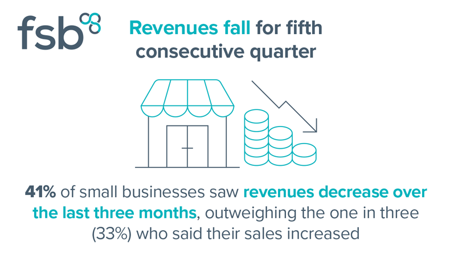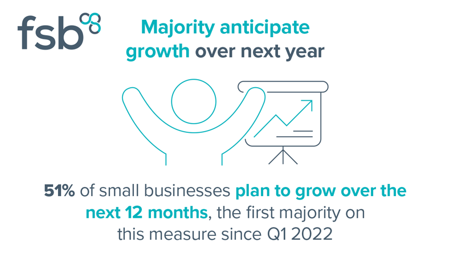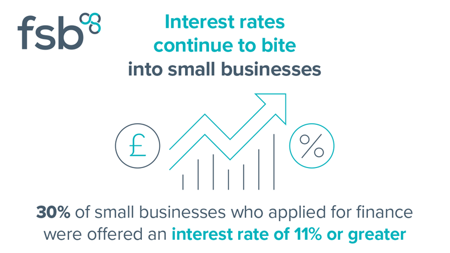Foreword

Tina McKenzie,
Policy & Advocacy Chair
It’s not really the result any of us wanted to see. The strong recovery in confidence seen in the first quarter did not carry through into this most recent research, as the upward momentum created by small firms’ optimism about the coming year took a tumble following base rate hikes and stickier-than anticipated inflation.
Still, there are green shoots of hope to be found, demonstrating once again the tenacity and resolve of small business owners. The headline confidence reading itself is a good deal higher than this time last year, when Russia’s invasion of Ukraine caused energy prices to spike, causing immense financial distress to small firms hit by utility bills which rapidly headed into the stratosphere.
The second quarter of 2023 was difficult revenuewise for many small firms. Two in five small firms reported a fall in sales, outweighing the one in three who saw a rise, as higher interest rates made consumers charier about spending. On the plus side, consumer confidence levels rose steadily over the second quarter, albeit remaining in negative territory.
Looking ahead, revenue expectations are something of a mixed bag, although it’s definitely good news that a majority of small firms – 51.3% - expect to grow over the next twelve months, the first time that over half have said this since Q1 of last year. The shorterterm outlook is a bit less positive, with the proportion of small businesses expecting sales to increase, at 32.4%, slightly outnumbered by those bracing for a fall, at 35.5%.
Another small bit of relief can be found in the proportion of small firms reporting higher costs than in the same quarter last year. In the Q1 research, this reached a record high of 91.8%, underlining the incredibly challenging conditions small firms were having to cope with in the midst of a vicious and seemingly relentless cost of doing business crisis. The fall-back of this figure to 84.9% is therefore to be welcomed as the first tentative sign that inflation might be starting to recede as a major concern. It’s definitely not worth pre-counting chickens, of course, but the bigger than predicted fall in inflation in the most recent post-Q2 figures is another hopeful indicator.
Now, small firms fear the prospect of interest rates overshooting the mark, staying too high for too long, and risking a recession. GDP growth over Q2 was hardly buoyant, and many small firms have as a result not been able to rebuild cash reserves worn thin over the course of the pandemic and the inflation crisis. This leaves them potentially vulnerable to external shocks, especially at a time when over half of small firms (52.0%) rate the affordability and availability of new credit as poor.
The upward march of the rates offered to finance seekers continued, with a record 30.4% of successful applicants offered a rate of 11% or more; in the same quarter last year, the equivalent figure was 12.2%. The 4.6% of finance applicants offered a rate of up to 4% is a record low, and a sharp tumble from 36.7% offered that rate in Q2 last year.
Small firms appear to be battening down the hatches to an extent around employment levels; over the next quarter, 15.5% expect to increase their payroll, down from 16.8% who expected the same in the first quarter, while 9.4% expect their employee numbers to decrease, up from 8.3%. It is however a small relief more small firms on balance expect to increase than decrease their employee numbers in the coming quarter, even though more small firms decreased (14.2%) than increased (11.8%) their staffing levels in the second quarter.
Exports recovered somewhat, with the proportion of small exporters who said their export levels had increased over the second quarter, at 33.4%, at the highest level since Q1 2019, and up from just 22.4% who reported an increase in the first quarter. Correspondingly, the level who said their export volumes had decreased fell from 40.2% in Q1 to 36.3% in Q2. And while expectations for export volumes in the coming quarter are relatively unchanged for the optimists (27.9% of small exporters in Q2 expect them to increase over the next three months, compared with 27.2% who said the same in Q1), there has been a decrease in pessimism, with 28.5% bracing for a fall in Q2, against 33.6% in Q1.
Looking at the bigger picture, small businesses are at something of a turning point in economic terms; with inflation finally appearing to have started to fall at a reasonable rate, pressure on margins may begin to lessen, giving small firms some much-needed breathing space.
As we look ahead to the autumn and the return of Parliament, politicians of all stripes would be well advised to consider the needs and aspirations of small firms and self-employed people, and consider how they might best help create the best conditions for them to grow and succeed.
Key findings



Executive summary
- The Small Business Index (SBI) fell to -14.2 in Q2 2023. This marked a return to contraction, following a sharp improvement in Q1. This had in turn followed three consecutive quarterly declines in 2022.
- All UK regions recorded a negative SBI reading in Q2. This highlights the widespread nature of the economic pessimism that has emerged across the UK. With the exception of the North West, every region saw a weaker SBI score in Q2 than in Q1.
- After unanimous quarterly improvement in Q1, all major industries saw their SBI readings fall back in Q2. This further highlights the widespread shift in sentiment amongst small businesses in recent months.
- The net balance of small businesses reporting revenue growth over the previous three months stood at -8.6% in Q2 2023. This marked a fifth consecutive negative reading, as businesses face the effects of weak domestic demand.
- The net balance of exporters reporting growth in the value of their exports improved in Q2 2023. However, the figure still remained negative, with a reading of -2.9%. Exporting businesses have on balance seen contracting export growth for the past seventeen quarters, amidst global economic pressures.
- The net balance of small businesses reporting a rise in their operating costs fell to 80.4% in Q2. This marked the first quarterly fall on this metric since Q3 2022 and the weakest reading since Q4 2021. It is important to note that this is still an historically elevated share, however.
- As has been the case in recent quarters, utilities ranked as the most commonly cited source of changing business costs in Q2. However, the share of businesses selecting this fell to 61.9% in Q2, down from 62.7% in Q1. There was a large increase in the share of businesses citing financing as a source of cost changes in Q2, likely reflecting recent interest rate hikes and their impact on commercial rates.
- A net balance of -2.4% of small businesses reported growth in employee numbers in Q2. This marks a fifth consecutive negative reading on this metric.
- The share of small businesses expecting to grow over the coming year increased to 51.3% in Q2. This put an end to four consecutive quarters in which only a minority of small businesses expected to grow over the next period.
- The domestic economy remains the most commonly cited barrier to growth amongst small businesses, with 61.5% of respondents selecting the category. This highlights the continued weakness posed by current demand conditions and corroborates with expectations of a recession later in the year. Meanwhile, there was a large fall in the share of respondents selecting utility costs as a potential barrier to growth over the coming year.
- Perceptions of credit affordability and availability worsened further in Q2. The share of businesses with positive opinions on overall credit availability and affordability fell to 11.8% in Q2, down from 12.3% in the previous quarter. Changing sentiment on credit also reflects recent interest rate hikes.
Download the full report




